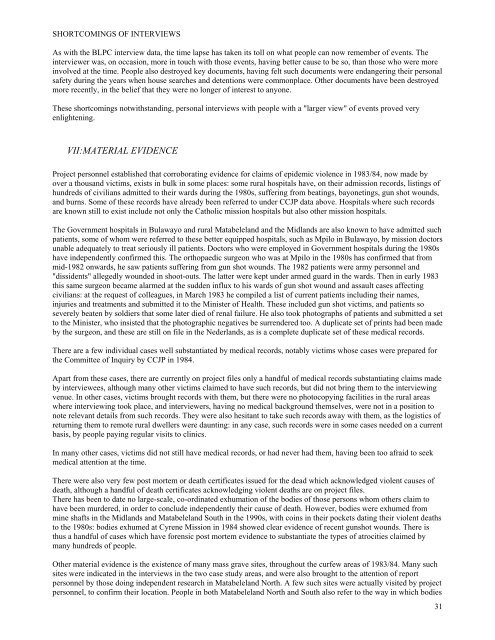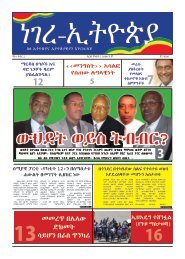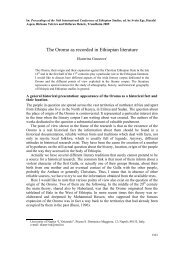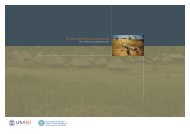MatabelelandReport
MatabelelandReport
MatabelelandReport
Create successful ePaper yourself
Turn your PDF publications into a flip-book with our unique Google optimized e-Paper software.
SHORTCOMINGS OF INTERVIEWS<br />
As with the BLPC interview data, the time lapse has taken its toll on what people can now remember of events. The<br />
interviewer was, on occasion, more in touch with those events, having better cause to be so, than those who were more<br />
involved at the time. People also destroyed key documents, having felt such documents were endangering their personal<br />
safety during the years when house searches and detentions were commonplace. Other documents have been destroyed<br />
more recently, in the belief that they were no longer of interest to anyone.<br />
These shortcomings notwithstanding, personal interviews with people with a "larger view" of events proved very<br />
enlightening.<br />
VII:MATERIAL EVIDENCE<br />
Project personnel established that corroborating evidence for claims of epidemic violence in 1983/84, now made by<br />
over a thousand victims, exists in bulk in some places: some rural hospitals have, on their admission records, listings of<br />
hundreds of civilians admitted to their wards during the 1980s, suffering from beatings, bayonetings, gun shot wounds,<br />
and burns. Some of these records have already been referred to under CCJP data above. Hospitals where such records<br />
are known still to exist include not only the Catholic mission hospitals but also other mission hospitals.<br />
The Government hospitals in Bulawayo and rural Matabeleland and the Midlands are also known to have admitted such<br />
patients, some of whom were referred to these better equipped hospitals, such as Mpilo in Bulawayo, by mission doctors<br />
unable adequately to treat seriously ill patients. Doctors who were employed in Government hospitals during the 1980s<br />
have independently confirmed this. The orthopaedic surgeon who was at Mpilo in the 1980s has confirmed that from<br />
mid-1982 onwards, he saw patients suffering from gun shot wounds. The 1982 patients were army personnel and<br />
"dissidents" allegedly wounded in shoot-outs. The latter were kept under armed guard in the wards. Then in early 1983<br />
this same surgeon became alarmed at the sudden influx to his wards of gun shot wound and assault cases affecting<br />
civilians: at the request of colleagues, in March 1983 he compiled a list of current patients including their names,<br />
injuries and treatments and submitted it to the Minister of Health. These included gun shot victims, and patients so<br />
severely beaten by soldiers that some later died of renal failure. He also took photographs of patients and submitted a set<br />
to the Minister, who insisted that the photographic negatives be surrendered too. A duplicate set of prints had been made<br />
by the surgeon, and these are still on file in the Nederlands, as is a complete duplicate set of these medical records.<br />
There are a few individual cases well substantiated by medical records, notably victims whose cases were prepared for<br />
the Committee of Inquiry by CCJP in 1984.<br />
Apart from these cases, there are currently on project files only a handful of medical records substantiating claims made<br />
by interviewees, although many other victims claimed to have such records, but did not bring them to the interviewing<br />
venue. In other cases, victims brought records with them, but there were no photocopying facilities in the rural areas<br />
where interviewing took place, and interviewers, having no medical background themselves, were not in a position to<br />
note relevant details from such records. They were also hesitant to take such records away with them, as the logistics of<br />
returning them to remote rural dwellers were daunting: in any case, such records were in some cases needed on a current<br />
basis, by people paying regular visits to clinics.<br />
In many other cases, victims did not still have medical records, or had never had them, having been too afraid to seek<br />
medical attention at the time.<br />
There were also very few post mortem or death certificates issued for the dead which acknowledged violent causes of<br />
death, although a handful of death certificates acknowledging violent deaths are on project files.<br />
There has been to date no large-scale, co-ordinated exhumation of the bodies of those persons whom others claim to<br />
have been murdered, in order to conclude independently their cause of death. However, bodies were exhumed from<br />
mine shafts in the Midlands and Matabeleland South in the 1990s, with coins in their pockets dating their violent deaths<br />
to the 1980s: bodies exhumed at Cyrene Mission in 1984 showed clear evidence of recent gunshot wounds. There is<br />
thus a handful of cases which have forensic post mortem evidence to substantiate the types of atrocities claimed by<br />
many hundreds of people.<br />
Other material evidence is the existence of many mass grave sites, throughout the curfew areas of 1983/84. Many such<br />
sites were indicated in the interviews in the two case study areas, and were also brought to the attention of report<br />
personnel by those doing independent research in Matabeleland North. A few such sites were actually visited by project<br />
personnel, to confirm their location. People in both Matabeleland North and South also refer to the way in which bodies<br />
31







